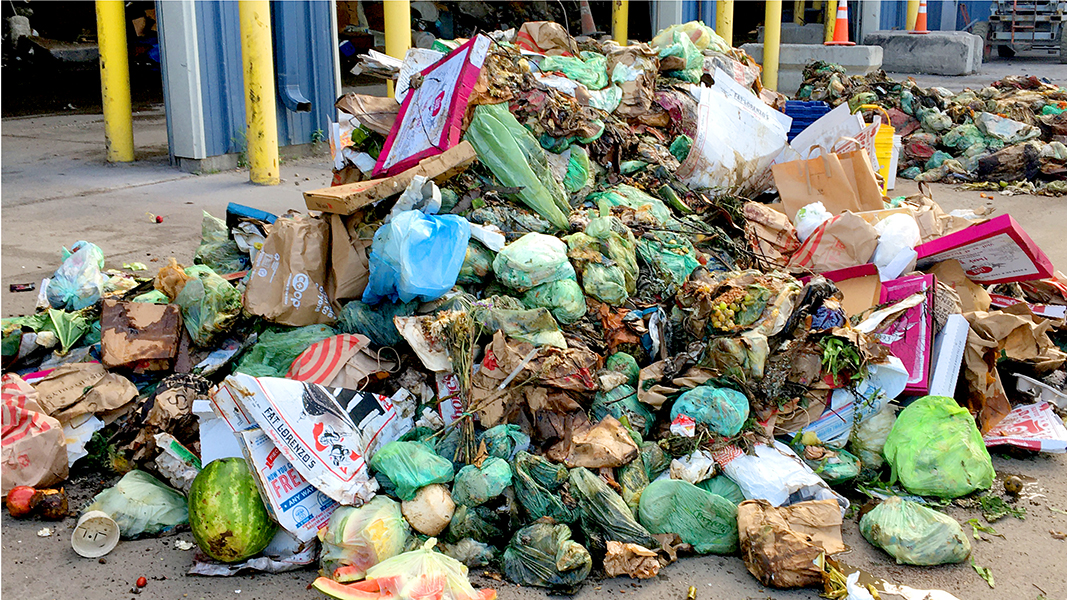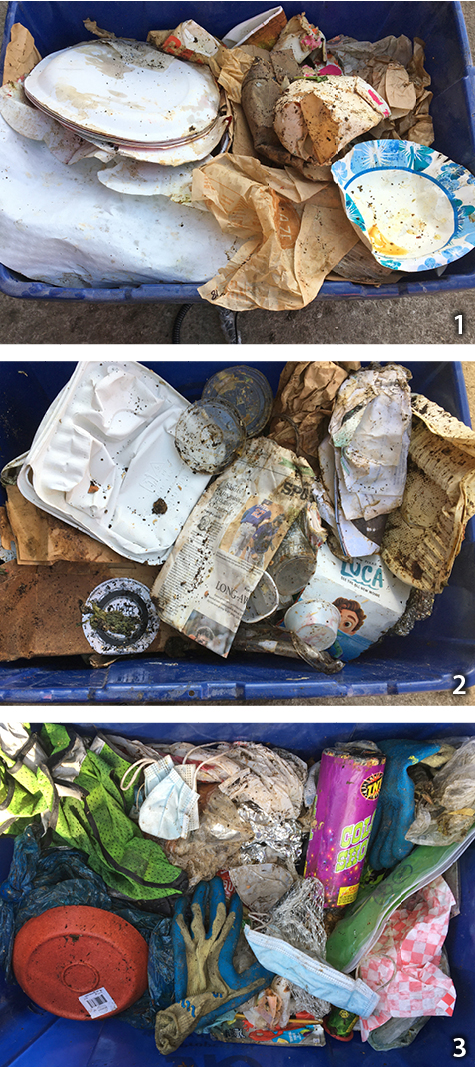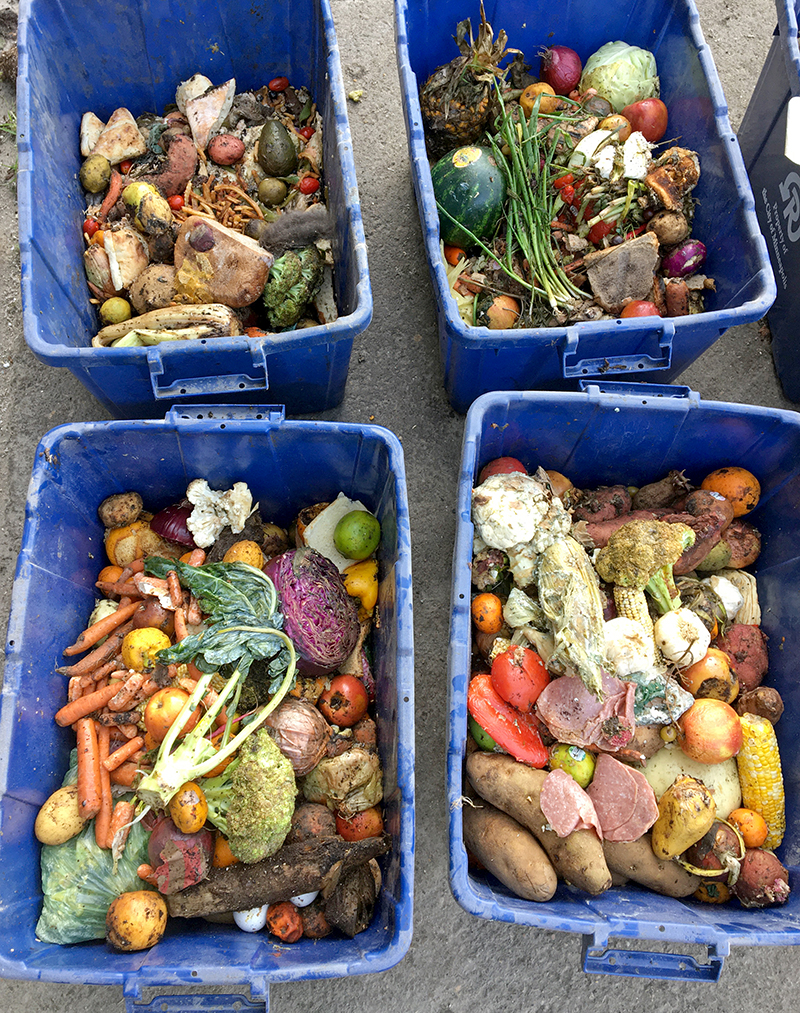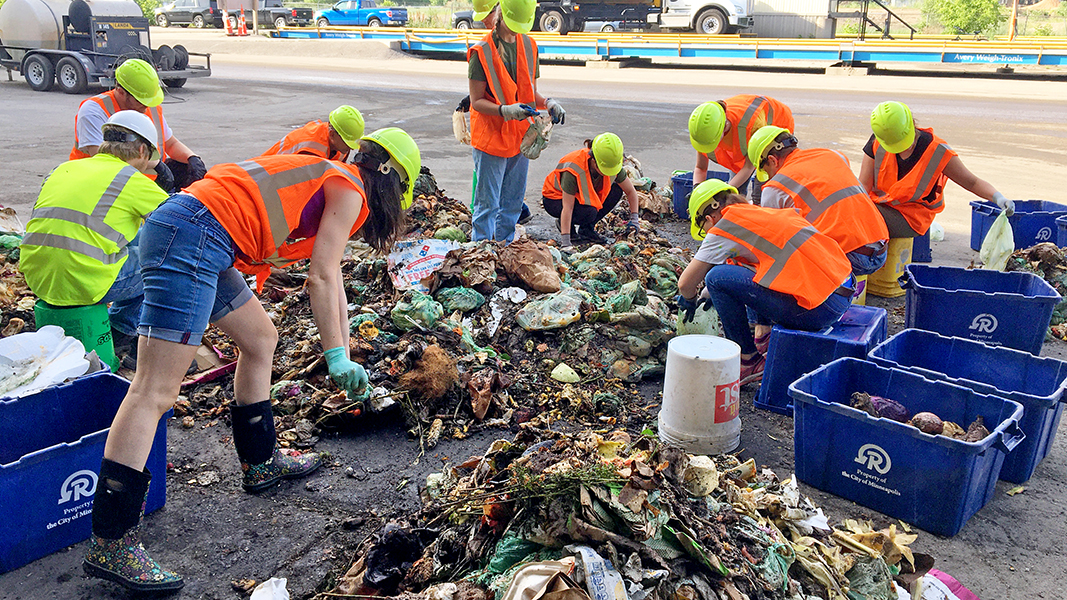Top: City staff and volunteers conduct a sort of source separated organics.
Nora Goldstein
The City of Minneapolis, Minnesota rolled out its residential curbside organics collection program in 2015-2016. Accepted feedstocks include all food scraps, food-soiled paper, BPI-certified compostable foodservice items and liner bags, and pizza boxes. Households “opt-in” to participate in the curbside program at no extra cost, and receive a 32-gallon green cart (64-gallon carts also are available) when they sign up. Yard trimmings are collected separately, from April through November.
The city also has organics drop-off sites in some of its parks. “We will be opening three new sites this fall and two next spring,” notes Kellie Kish, Recycling Coordinator at the City of Minneapolis’ Solid Waste & Recycling division. “Once all are open, there will be 20 organics drop-off sites in the City available to households.” The same materials as the curbside program are accepted.
 The city’s Solid Waste & Recycling division provides weekly organics and trash collection and biweekly recyclables collection to all single-family residences and up to 4-unit multiplexes. It also services municipal buildings and the city parks, and small businesses that opt-in for collection services. All residents are charged a base fee of $25.08/unit/month. Fees for trash collection vary by the size of the cart — $5/month for a 96-gallon cart and $2/month for a 32-gallon cart. Table 1 highlights the sign up rates for the curbside organics collection program since it began, and the annual tons collected. As of July 5, 2021, 50.68% of residential solid waste services customers (54,583 households) have signed up to participate.
The city’s Solid Waste & Recycling division provides weekly organics and trash collection and biweekly recyclables collection to all single-family residences and up to 4-unit multiplexes. It also services municipal buildings and the city parks, and small businesses that opt-in for collection services. All residents are charged a base fee of $25.08/unit/month. Fees for trash collection vary by the size of the cart — $5/month for a 96-gallon cart and $2/month for a 32-gallon cart. Table 1 highlights the sign up rates for the curbside organics collection program since it began, and the annual tons collected. As of July 5, 2021, 50.68% of residential solid waste services customers (54,583 households) have signed up to participate.

Two collection routes have been sorted consistently over the years to establish a baseline. Several other routes from around the city are added each time a sort is done. Photos courtesy of Minneapolis Solid Waste & Recycling
Household Organics Sorts
Solid Waste & Recycling staff has been conducting sorts of materials set out in the curbside organics program since 2017. The organics sorts are used to determine the most prevalent contaminants in materials set out, which in turn guides outreach and education. “Collecting information and data on all of our programs is critical to our solid waste operations,” says David Herberholz, the City of Minneapolis’ Director of Solid Waste & Recycling. “We spent a few million dollars to upgrade our internal data management system. I am a big believer in the saying, ‘you can only manage what you can measure.’ We do that via waste and organics sorts and other tools.”

Contamination in collected organics is sorted into three categories: (1) Plastic-lined paper; (2) Recyclables; and (3) Other (garbage).
Solid Waste & Recycling staff and volunteers conduct the sorts at SKB’s Malcolm Transfer Station. After the selected route is delivered, a front-end loader levels out the pile. Volunteers tear open every bag and dump out the contents. Contaminants and food that could have been eaten are put into separate bins. Yard trimmings, although not considered contamination, are also set aside as those are collected separately from organics in the City’s program.
After the initial sort is completed, contaminants are re-sorted into three categories:
- Plastic-lined paper, e.g, to-go containers, paper cups, food wrappers, shiny paper plates, ice cream tubs, pizza box liners, etc.
- Recyclables: Cardboard, large stacks of newspaper, plastic bottles and cups, polypropylene to-go containers (#6 plastic), yogurt cups, aluminum cans, boxboard, cartons, etc.
- Other contaminants (referenced as garbage): Non-BPI certified compostable plastic bags, utensils, straws, nonrecyclable or compostable plastic cups and containers, sauce packets, meal delivery service packaging, etc.
Staff and volunteers use blue recycling bins for the sorted materials. Once the sorting is done, all containers are weighed. “Conducting a sort takes about eight hours of my staff time, and an extra 15 minutes for a crew to deliver the materials to the sorting site,” explains Kish. “Volunteers provide much of the labor. As far as equipment, we need the recycling bins, shovels and gloves. It is not expensive to do.”
Sorting Data
The first organics sort was completed in March 2017 to determine the most prevalent contaminant. “We selected two collection routes and have been using those for our sorts since we started to maintain a baseline,” says Kish. “One of the routes (502) is in a South Minneapolis neighborhood that had an organics drop-off location so we knew some households were already recycling their food scraps and other materials. The second route (631) is in a North Minneapolis neighborhood where there were issues with contamination in the recycling bins. We wanted to track the quality of organics set out. In 2018, we began adding in two or three additional routes for each sort to get data from across the city.”
The first sort in March 2017 identified plastic-lined paper items as the most common contaminant. A cart hanger was created to address this contaminant and sorts were conducted again in May and June 2017 to determine the effectiveness of the cart hanger. Overall contamination increased slightly after the cart hanger was left on the 502 route, and dropped dramatically — from 23.33 lbs to 9.7 lbs on the 631 route.
Sorts have continued annually, with the exception of 2020 due to the global coronavirus pandemic. Contamination increased slightly in 2021 vs. 2019 as have the number of households signed up to participate. Average contamination levels are shown in Table 2. “In our more recent sorts, plastic-lined paper is still the largest category of contamination, followed closely by other contaminants,” says Kish. “There seems to be confusion about meal delivery service packaging. Some of the contamination from that source is labeled compostable but it isn’t.”
 She adds that the Minnesota Composting Council has been working with composters, product manufacturers, local units of government and the Minnesota Pollution Control Agency to amend MN Stat. 325E.046 Standards for Labeling Plastics Bags to apply to foodservice products and other packaging claiming compostability. The legislation, which did not pass in the 2021 session, is being reintroduced in 2022. The bill proposes that products can only be labeled compostable if they meet ASTM D6400 or ASTM D6868 standards and the results are verified by a third party who is a nonprofit capable of performing necessary analysis.
She adds that the Minnesota Composting Council has been working with composters, product manufacturers, local units of government and the Minnesota Pollution Control Agency to amend MN Stat. 325E.046 Standards for Labeling Plastics Bags to apply to foodservice products and other packaging claiming compostability. The legislation, which did not pass in the 2021 session, is being reintroduced in 2022. The bill proposes that products can only be labeled compostable if they meet ASTM D6400 or ASTM D6868 standards and the results are verified by a third party who is a nonprofit capable of performing necessary analysis.
Edible Food

In 2018 edible food began to be pulled from the sort loads. “We define edible food as anything that could have been eaten, e.g., three-quarters of an onion or meat that is still in its packaging, but is ending up in the organics cart,” notes Kish. “Solid Waste & Recycling’s 2020 COVID waste behavior survey showed residents are cooking at home more and feel more aware of the waste they create, however, the percentage of edible food in the organics increased from 2019 sort levels. It is disheartening given the amount of food we found. This proves more education is needed to make sure edible food is consumed.” The City is using the results to help develop public messaging around purchasing habits and tips to reduce wasted food.

Edible food falls into three general categories — vegetables, fruit, and other, which includes meat, prepared food, eggs and dairy.
In 2021, edible food from two routes (504 and 631) was sorted by type: 1) Vegetables, 2) Fruit, and 3) Other (meat, prepared food, eggs, bread, dairy). Sorters found 16 pounds of prepackaged cheese slice packets in route 631 materials. The most common edible food items found included potatoes, oranges (including clementines), onions, carrots, limes, lemons, and apples. Figure 1 shows the edible food sorted out by type.
Collection And Contamination Management
Between 70% and 80% of residential trash, organics and recycling collection is done in alleys in Minneapolis. “We have rear-load trucks with semi-automated lifts,” says Herberholz. “Because of the narrow alleys and low power lines we never went to fully automated collection. Drivers are also educators — our ‘feet on the street’ — as they are able to lift the lids of containers and see what is inside. If they see obvious contamination, they don’t empty the cart and leave a hanger tag explaining why the materials were not collected. The tag is followed up by a direct mail letter explaining materials accepted in the recycling and organics carts and the city’s policy about rejecting carts with contamination. If drivers have to issue multiple tags, the cart is removed.”
When drivers find items that are questionable about whether they are accepted, they will wrap them up and bring them to Kish to examine. “All information collected by the drivers feeds into our internal system, which enables us to track common contaminants in the recycling and organics bins,” he adds. “For recycling, plastic bags are the most common.”
In Spring 2022, Solid Waste & Recycling plans to conduct a capture rate study to help learn the quantity and types of organics and recyclables being captured at a household level, and what is still remaining in the trash. Data collected will aid in further fine-tuning outreach and education programs and materials.
To dive into the data from the organics sorts download an excellent report prepared by Solid Waste & Recycling.













